Table of contents
- Electronic driver assistance systems for motorcycles Current status and outlook for the future
- How do you actually define the term assistance systems??
- Many motorcyclists are skeptical about new technologies
- Modern electronics can increase reliability
- Who buys a used GS without ESA??
- General classification of driver assistance systems
- Poll – that’s what the readers say
- Anti-lock braking systems
- Different driving modes
- Traction control
- “Electronic” trolleys
- Curve light
- Cruise control
- Gearshift assistant / automatic gearshift
- Double clutch
- Wheelie / stoppie control
- Future projects
- How well the display and operation work?
- Advantages and disadvantages of assistance systems
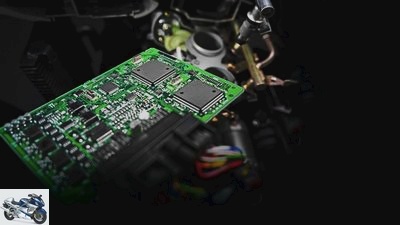
Yamaha
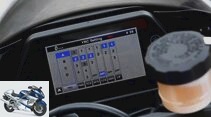

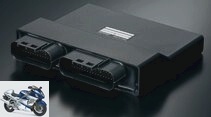
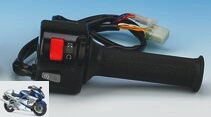
35 pictures
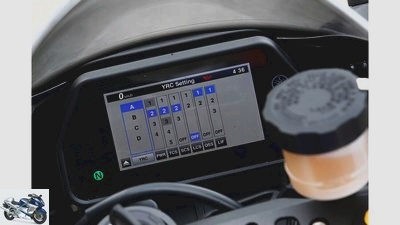
www.factstudio.de
1/35
How things are going? It was a long way from the almost purely mechanical cockpit of the Yamaha SR 500 to the digital dashboard of the current YZF-R1. Many functions also require space for the display.

BMW
2/35
Not only current super sports cars like this BMW HP4 Sport drive full of invisible electronics. Fine sensors help control technology.
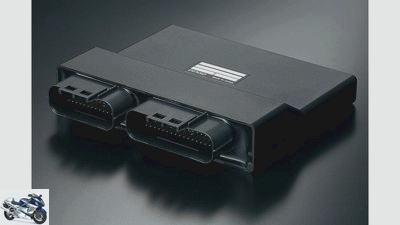
Suzuki
3/35
Electronic brain and black box: You can’t tell from compact control units that they are so powerful.
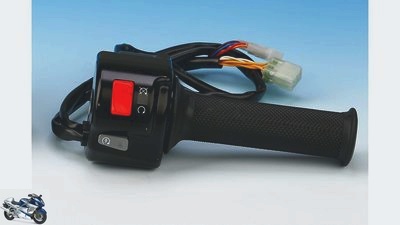
www.factstudio.de
4/35
Goodbye throttle cable: Ride-by-wire was an important prerequisite for the development of many electronic assistance systems. The throttle valves are no longer opened or closed mechanically via Bowden cables…
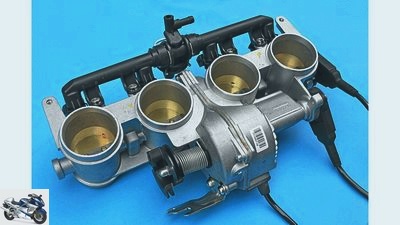
archive
5/35
…Rather, the electric throttle serves as a potentiometer for the engine control. An electric servomotor implements commands from the throttle hand with a variable transmission ratio.
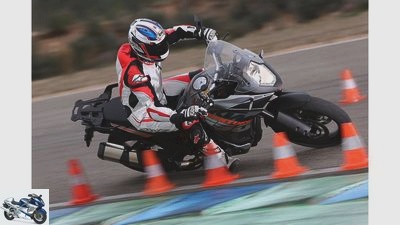
markus-jahn.com
6/35
ABS on board helps maintain stability and safety.
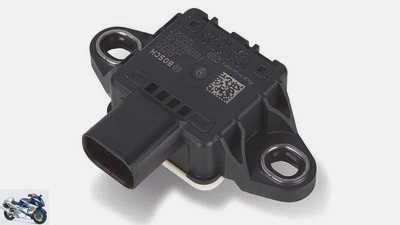
KTM
7/35
Motion detector: The Bosch five-axis gyro sensor provides data on three linear and two angular accelerations.
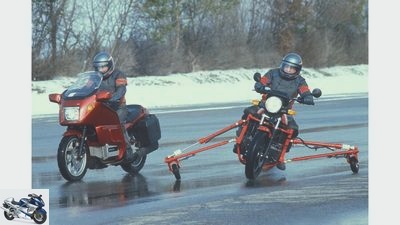
archive
8/35
Every beginning is cross. ABS is the mother of all electronic assistance systems. BMW was a pioneer in 1988 with the K 100.
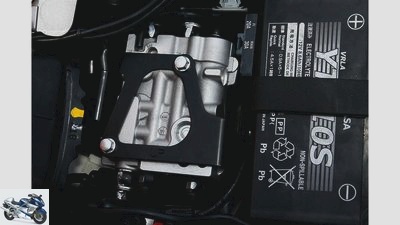
www.factstudio.de
9/35
The hand lever and pedal are not connected to the brake calipers, they only supply signals to the main hydraulic cylinder.

www.factstudio.de
10/35
The Honda Fireblade always brakes in combination at the front and rear using “brake-by-wire”.
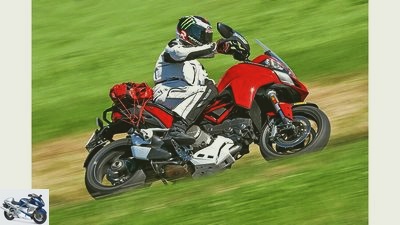
jkuenstle.de
11/35
The claim to be several motorcycles in one,…
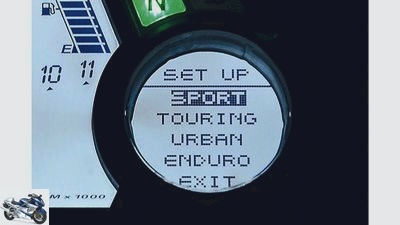
jkuenstle.de
12/35
…machines à la Ducati Multistrada owe 1200 different driving modes.

markus-jahn.com
13/35
Accelerate out in a new way: Less lean angle results in more power output.
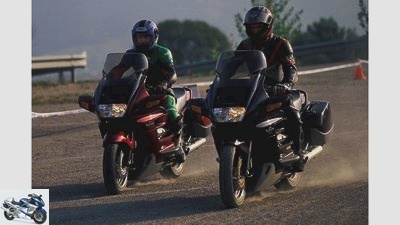
www.factstudio.de
14/35
As early as 1992, the Honda ST 1100 was the first motorcycle to have an optional “anti-slip control” (ASR).
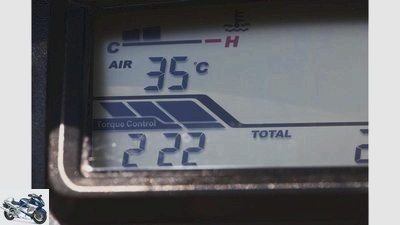
archive
15/35
Today, multi-stage, finely-regulated systems are the norm, as is the case with Honda’s Crosstourer.
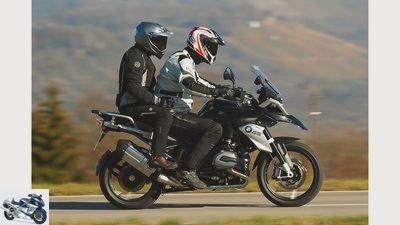
www.bilski-fotografie.de
16/35
“Electronic” chassis: BMW was the pioneer, now even offering semi-active damping for the 1200 GS.

jkuenstle.de
17/35
Level control: The Aprilia Caponord 1200 Rally autonomously adjusts the spring base to the load with ADD.
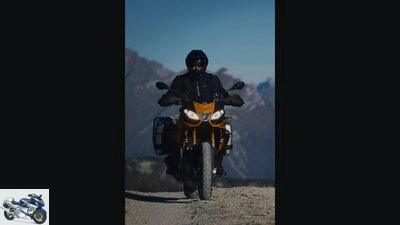
Aprilia
18/35
Level control: The Aprilia Caponord 1200 Rally autonomously adjusts the spring base to the load with ADD.
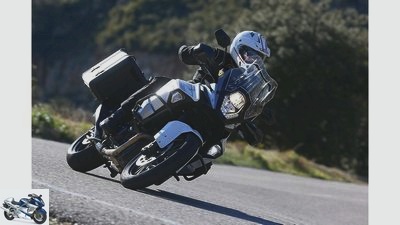
markus-jahn.com
19/35
Groundbreaking safety feature: cornering lights, here on a 1290 KTM, for better illumination of the inside of the lane.

BMW
20/35
In the BMW six-cylinder engines, adaptive headlights for the xenon dipped beam are controlled by a swivel mirror in two axes.

jkuenstle.de
21/35
The low beam of the K 1600 GT compensates for inclined positions of up to 25 degrees and shines almost horizontally into the curve.
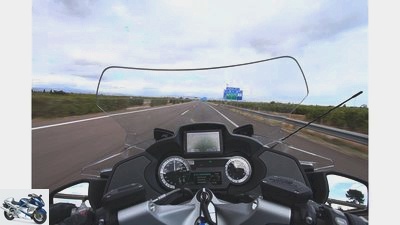
–
22/35
This is where cruise control makes the most sense: on motorways with little traffic, especially in countries with speed limits. A convenient feature not only in cars.

BMW
23/35
Only for super athletes? No, even if this is a BMW S 1000 RR: In general, quickshifters are on the rise.
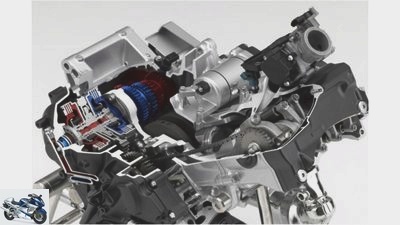
Honda
24/35
One clutch creates a frictional connection for the odd gears, the other for the even gears.
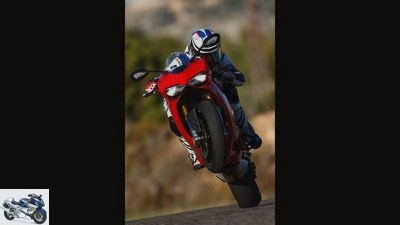
jkuenstle.de
25/35
Up the bike – but only if you really can and want it!
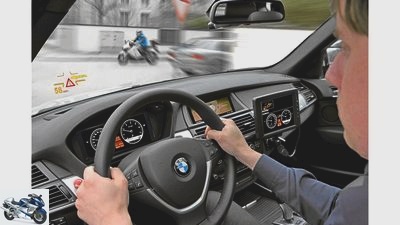
BMW
26/35
The test phase is already running: In networked vehicles, drivers are warned of approaching motorcyclists.

BMW
27/35
Already standard: in some BMWs, the brake light flashes during emergency braking and switches on the hazard warning lights before the vehicle comes to a standstill.

www.bilski-fotografie.de
28/35
Save fuel in the city: Honda’s PCX 125 was the first scooter with an automatic start-stop system in 2010.
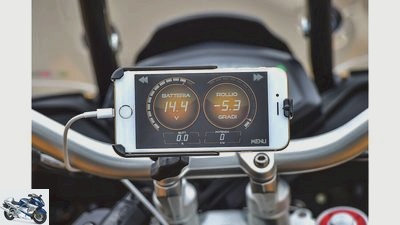
Aprilia
29/35
Big Brother: Aprilia’s multimedia platform uses the smartphone as an extended on-board computer, stores all driving data there (!)
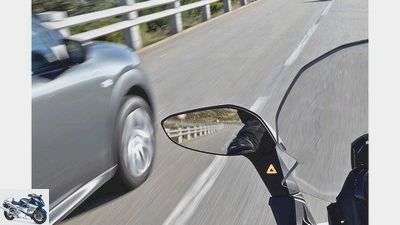
BMW
30/35
Pioneer: Since 2016, the luxury scooter BMW C 650 GT has been the first two-wheeler in the world to have an optional blind spot warning system in the mirror base.
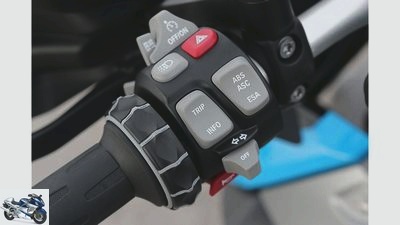
www.bilski-fotografie.de
31/35
User-friendly: separate switches on a BMW, e.g. for cruise control and electric window.
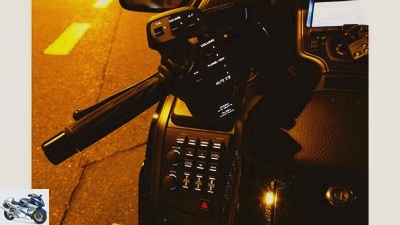
www.bilski-fotografie.de
32/35
Praiseworthy: the illuminated switches of the Honda Gold Wing. But their fittings are completely overloaded with (radio) switches.
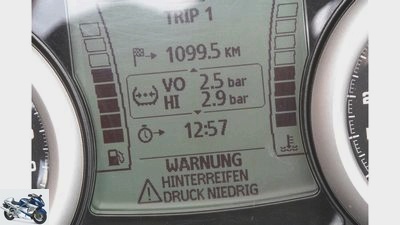
Thomas Schmieder
33/35
Digital tire pressure control of the Triumph Trophy SE – here with malfunction due to empty sensor battery at correct pressure.

www.bilski-fotografie.de
34/35
Karsten Schwers, MOTORRAD test driver and an artist at the handlebars, thinks machines that are crammed with assistance systems are great.
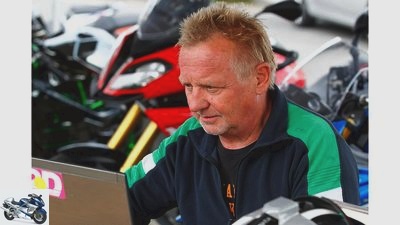
www.factstudio.de
35/35
Werner “Mini” Koch, MOTORRAD test driver and editor since 1987, asks himself critically what happens to the sensors, computers and control valves when the machine gets old?
counselor
technology & future
Electronic driver assistance systems for motorcycles
Electronic driver assistance systems for motorcycles
Current status and outlook for the future
The motorcyclist fluctuates between classic, simple retro bikes and modern high-tech machinery. But no question about it, bits and bytes are on the rise. Used wisely, they make driving safer, easier and more relaxed. What is the current state of the art, what will the future bring??
Thomas Schmieder
09/01/2016
Yamaha’s YZF-R1 was a real blast in 1998, a 150-horsepower lightweight with plenty of torque, poisonous brakes and heavy acceleration. “The R1 could only be mastered with a lot of feeling in the throttle, fine motor performance on the brakes and a highly sensitive popometer: It separated the wheat from the chaff,” remembers MOTORRAD veteran Mini Koch. Gross motor skills simply threw them off, they fluttered helplessly on the handlebars during a wheelie or grabbed their ears when braking in an inclined position. Nice anecdotes from times gone by? Not only, unfortunately, there were also serious accidents involving overwhelmed R1 drivers.
Buy complete article
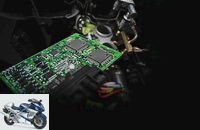
Electronic driver assistance systems for motorcycles
Current status and outlook for the future
12 pages) as PDF
€ 2.00
Buy now
A lot has changed since then. Today, a lot of driver assistance systems work discreetly in the background in super athletes. Thanks to ABS, traction and wheelie control, various driving modes and electronically regulated spring elements, even 200 HP grenades can now be mastered. Electronics has made considerable progress here and is a safety gain. Take ABS, for example: MOTORRAD has been campaigning for this since 1988, initially against fierce resistance from conservative, traditional drivers. Today even tough racers insist on it.
How do you actually define the term assistance systems??
Driver assistance systems are therefore not incapacitated. But one thing is certain: unlike cars, motorcycles will never drive autonomously. So let’s look at the assistance systems for what they want to be: as helpers that bring safety, increase comfort, and possibly even increase driving pleasure.
But how do you actually define the term assistance systems? In principle, they existed long before the electronic age. Even the first electric starter is one of them – after all, you no longer had to kick a game. Adjustable hand levers and adjustable seat height? All useful helpers for safe operation. Hundreds of kilometers in the rain at single-digit temperatures? No problem today, just raise the windshield and turn on the handle heating. Fidgeting front while accelerating out? A steering damper reduces. All of these are electrical and / or mechanical driving aids.
Many motorcyclists are skeptical about new technologies
The following article is about modern driver assistance. In other words, digital technologies based on bits and bytes, circuit boards, computers and sensors. Active safety always has the highest priority, especially when it comes to motorcycles. So defuse dangerous situations or do not allow them to arise in the first place. As I said, ABS for everyone has been the most important topic of the past decade in this regard. Other, perhaps less important, technologies will follow. Apart from that, the motorcycle is also about the comfort and sportiness of modern machines, i.e. driving pleasure, see the following individual considerations.
Even if progress can never be stopped, many motorcyclists are rather skeptical or indecisive about new technologies, see “That’s what the readers say”. Because they don’t know them or don’t need them? One argument is certainly correct: the most important on-board computer is still wearing a helmet. And driving physics cannot be outwitted – the road scanner is still the driver and he has to make the right decisions. So stay alert, don’t blindly rely on electronic lifeguards. This is not a fully electronic fully comprehensive world!
Modern electronics can increase reliability
On the other hand, anyone who thinks, because of the helpers on board, that they are taking more risk, can push the boundaries further, has not understood it either. On the other hand, it is important not to be distracted by excessive operating menus while driving. In driver training courses you can get to know your assistance systems well and try out the function and effect of ABS or traction control in the control range.
Reservations about complex electronics often come from the fact that one does not understand how they work. Many also fear that defects can usually no longer be repaired yourself. However, past experience has shown that modern electronics can even increase reliability. For example, injection: Today it works better and more reliably than carburetor technology. Most control loops also monitor themselves using onboard diagnostics.
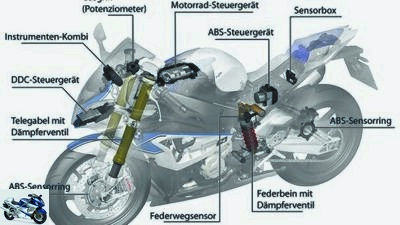
BMW
Not only current super sports cars like this BMW HP4 Sport drive full of invisible electronics. Fine sensors help control technology.
But if breakdowns occur less frequently: If the electronics are broken, things get complicated and often expensive. Reading out via diagnostic plug is no longer for the nice mechanic next door, it needs expensive special equipment. Mechatronics engineers check and replace instead of repairing. And what do you do when the machine is ten or twelve years old? Is every defect a total loss? And do the expensive electronic components still exist? Such concerns need to be taken seriously, see “Pros and cons”. MOTORRAD editor Klaus Herder had damage to his BMW K 1200 GT after a year and a half of downtime: the pistons in the ABS pressure modulator were defective because of the three-year-old brake fluid. As a spare part, it costs well over 1000 euros, and a repair by a specialist costs 750 euros.
The automotive industry is setting the standards for on-board electronics today, and motorcycle manufacturers are gradually following suit. In the case of cars, new trends start in the upper class, then penetrate the entire market via the middle class. When it comes to motorcycles, luxury tourers or super athletes usually start with new technology. Here, too, it spreads from top to bottom. Take traction control, for example: a few years ago, this feature was reserved for exclusive sports machines, today some entry-level bikes already have it.
Who buys a used GS without ESA??
Ride-by-wire is a prerequisite and basis for many assistance systems. Only the throttle valves operated by a servomotor allow different driving modes. A cruise control now only needs some software and a switch. E-gas also helps adapt traction and wheelie controls; it even makes the engine brake variable by simply opening the throttle valve minimally in overrun mode. Despite all the skepticism about bits and bytes: If the customer has a choice, he prefers to take the full program. Today a GS is almost always ordered with lots of extras from Pro riding modes to shift assistants to ESA electronic suspension. Of course, in the back of your mind there is always a bit of a resale opportunity. According to the motto: Who will buy a used GS without ESA? But first and foremost, buyers want function, gain in luxury and comfort. Is a tire pressure sensor a stupid idea if the valves are difficult to reach? Of course one can smile at a hill start aid as an “electronic brake wedge”. But hardly if you have to balance a fully loaded half-ton truck with a passenger on the back on the steep alpine pass on one foot.
If you believe the survey, reservations about automated transmissions are particularly great. But Honda’s DCT dual clutch transmission has nothing in common with the clumsy two-speed automatic converter of the Moto Guzzi V 1000 Convert or the performance-guzzling, blaring variator of scooters. It works great, it’s fun. Functions and networking are increasing. But at the end of the day, the customer determines where the path is going. Does it require more modern full equipment or does it prefer conventional mechanics? So it fits well that the BMW R nineT and R 1200 RT coexist peacefully, with the Honda Crosstourer DCT or Africa Twin, with Ducati Multistrada and Scrambler.
General classification of driver assistance systems
| Operating- relief |
|
- Systems that increase operating or driving comfort
- Heated grips, heated seats, shift assistant
- Information systems
- Warning systems
- Systems that only inform
- Systems that inform vigorously, thus warn
- GPS, adaptive headlights, fuel gauge
- Tire pressure control, reserve display
(intervening)
- Assistive systems
- Semi-automatic systems
- Systems that “actively” intervene in vehicle guidance and submit a suggestion to the driver
- Systems that are monitored and overridden by the driver and take over part of the driving task
- Shift recommendation, shift light
- Cruise control, dual clutch transmission,
Hill start assist
(acting)
- Fully automated systems
- Systems that function fully autonomously and cannot currently be overridden by the driver
- ABS, cornering ABS, integral braking systems, traction control, semi-active chassis
* according to Kuschefski, Haasper and Vallese, Institut fur Zweiradsicherheit e.V. (ifz), 2010 (changed)
Poll – that’s what the readers say
Interesting what motorcyclists think: The rejection of electronic assistance systems in this online survey, which is certainly not representative, is generally greater than the approval. Only ABS and, to a lesser extent, cornering ABS, traction and tire air pressure control find broad approval. Often, however, around two thirds are still undecided. The many “neutral” ratings indicate that many drivers have not yet formed an opinion on the subject. If you want to know more: www.motorrad-aber-sicherheit.com shows ten films about assistance systems that are well worth seeing.
What do you think of…
| Therefore | Neutral | On the other hand | …electronic aids on the motorcycle? | 15.8% | 67.6% | 16.6% | …SECTION? | 75.4% | 22.2% | 2.4% | …Cornering ABS? | 27.7% | 66.7% | 5.6% | …Traction control? | 25.3% | 60.5% | 14.2% | …Wheelie control? | 10.3% | 63.2% | 26.5% | …Launch control? | 4.4% | 65.2% | 30.4% | …Riding modes / selectable maps? | 16% | 66.3% | 17.7% | …Hill start assistant? | 3.6% | 56.8% | 39.6% | …electronically adjustable suspension? | 14.6% | 67.5% | 17.9% | …semi-active suspension? | 9.8% | 71.8% | 18.4% | …Cruise control? | 12.4% | 60.3% | 27.3% | …Tire pressure control? | 24.3% | 59% | 16.7% | …adjustable motor brake / Drag torque control? |
3.2% | 67.1% | 29.7% | …Shift assistant? | 14.5% | 63.4% | 22.1% | …semi-automatic transmission? | 2.1% | 54.4% | 43.5% | …automatic transmission? | 2.3% | 36.8% | 60.9% |
* 2818 readers took part in the survey at www.motorradonline.de in August 2016. thank you very much!
Anti-lock braking systems
Braking on gravel or sand? In the wet, on an incline or in an acute emergency? Difficult. Only ABS on board helps to maintain stability and safety.
Hand on heart, dear MOTORRAD readers: Who still remembers the days of wildly smoking, violently transverse rear tires when braking hard? If a car took the right of way and panic burst the top of your head: “Please don’t overbrake the front wheel and get off.” Balancing on the brake lever was the order of the day. It’s just stupid when the locking rear wheel got into your limbs as a fright, and coordination and concentration could hardly be mastered. Tricky. The author himself had two falls in the 1990s, when the very first tap on the brake lever ended with the front wheel suddenly collapsing and long slides. Okay, on a wet road. But shouldn’t that mean braking? These falls came so incredibly quickly that there was no time to react. But they would have been avoidable. With ABS. MOTORRAD editor-in-chief Michael Pfeiffer wrote years ago: “You don’t have to discuss ABS anymore, you just have to have it!” Here you go: From 2017, new machines over 125 cubic meters across the EU will only be allowed with ABS. The culmination of a development that began in 1988 with the first ABS in a series motorcycle, a BMW K 100. At that time, the components required for this still weighed eleven kilograms. The basic structure of the hardware is still similar today: additional hydraulic lines to the pressure modulator, a control unit and perforated disks to determine the wheel speed on the brake disks.
But today’s systems only weigh around 2.5 kilograms and are much smaller and more compact. Above all, they control much better thanks to modern software and faster valves. On asphalt with changing surfaces (sudden changes in the coefficient of friction) and in wet conditions, ABS can do much more than human motor skills. Especially when there are moments of shock or inclination. Bits and bytes regulate the ideal brake pressure finer and faster in milliseconds: strong, weaker if there is a risk of blocking, stronger again, and so on. ABS is now even suitable for bends, the KTM 1190 Adventure 2014 with MSC made the start. Since then, the automotive giants Bosch and Conti have been equipping more and more machines with cornering ABS. Gyro sensors as “electronic spirit levels” make it possible – all that was necessary was a software update. The effect is astonishing, even at a 40 degree incline you can fully reach into the iron while maintaining the curve radius: the system modulates the brake pressure depending on the incline. In dry conditions, even modern ABS without a special cornering function allows full braking up to 35 degrees, but allows the motorcycle to straighten up. This was the result of tests in MOTORRAD 23/2015.
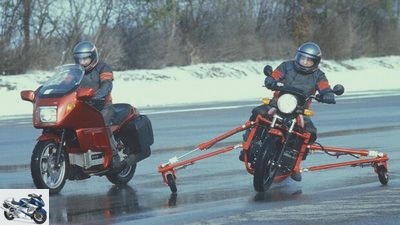
archive
Every beginning is cross. ABS is the mother of all electronic assistance systems. BMW was a pioneer in 1988 with the K 100.
Depending on the situation and motorcycle concept, the front wheel transfers around 70 to 80 percent of the braking force through dynamic wheel load distribution, the rear wheel the rest. Combined or composite braking systems help with the interaction. “Fully integral” means that both the brake lever and the pedal act at the front and rear, with partially integral actuation only one of the two. The idea behind it is simple, always to achieve the shortest possible braking distance. Honda installed various types of combination brakes in various models. Many BMWs brake in an impressively simple and practical manner: the hand lever pinches all three discs, the pedal only at the back – good when turning or turning. When braking hard on dry, grippy asphalt, the rear wheel can lift off in extreme cases. Special software can reduce this by reducing the brake pressure at the front (avoidance of rollover).
Different ABS modes in the same motorcycle help adapt to varying conditions, from rain to the racetrack. With race and enduro functions, ABS is often only active on the front wheel so that the rear wheel can be turned on.
MOTORCYCLE conclusion: Anti-lock braking systems bring the greatest safety gain on two wheels and are standard equipment today, and even mandatory from 2017. Now it is increasingly about even finer control quality and more suitability for bends, the future will bring further improvements.
Different driving modes
Travel or lawn? Different driving modes can change the character of the motor (bike) decisively.
A question of attitude: Do you bolt full Lotte with your buddies over the house route, or do you go on vacation gently with the cautious pillion on the back? Is the road flooded or is it on dry, grippy gourmet asphalt? Depending on the situation, responding more gently to the twist of the e-throttle or jagged, wild throttle response is the order of the day. As it fits.
Responsible for this are different maps, new German mappings, stored for different driving situations. They translate the commands of the throttle, which acts as a potentiometer, progressively, linearly or degressively. The maximum power output and the torque curve can also vary.
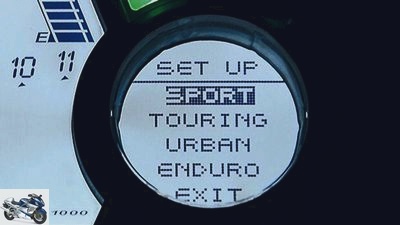
jkuenstle.de
Machines à la Ducati Multistrada owe their claim to be several motorcycles in one with 1200 different riding modes.
But nowadays this technology no longer includes the engine alone. Now “everything is networked with everything”, intervention thresholds and control parameters of ABS and traction control are often linked to the driving modes. The new Multistrada 1200 S is supposed to be transformed into a touring machine, an athlete, an all-terrain or city runabout at the push of a button. All by the technicians combining various adjustments of the engine, suspension elements (!) And assistance systems in four driving modes that can be called up at the push of a button.
On the go, the driver can snap back and forth between Sport, Touring, Urban or Enduro on the handlebars at lightning speed. The on-board electronics immediately take care of the right power output and a corresponding response behavior of the V-Zwo, the necessary chassis setup and supportive interventions by the traction control that is also influenced. Something like that is not a dilution, but ultimately a sharpening of the character.
MOTORCYCLE conclusion: Being able to react to different conditions with clearly distinguishable driving modes is a real advantage. When even an icon like the Triumph Speed Triple has five different driving modes on board since 2016, one thing is clear: more bandwidth means more safety and, at the same time, more driving fun.
Traction control
It takes away the fear of gravel when cornering and helps when accelerating out of the blue, even in wet conditions: traction control is now a must-have, especially for extra-powerful super athletes!
Even the most experienced racing drivers have respect for a highsider: If the rear tire suddenly slips away when accelerating on a steep lean angle, but then turns sideways, especially when you intuitively shut down the gas. Due to the sudden erection moment, the tire suddenly builds up grip again. The resulting impulse usually catapults the driver off the motorcycle in a high arc. The landing that follows is hard, often resulting in broken bones and major damage to the motorcycle – it usually lands on the outside of the curve (hence the name “high” – as opposed to the “lowsider”). These days, intelligent traction controls prevent that. Initially, the focus was still on safety on dirty or wet roads, including smooth bitumen stains or metal bridge heels. There the rear wheel can spin straight ahead even when accelerating.
Modern systems ensure maximum acceleration with controlled slip (deviation of wheel speed from vehicle speed). The regulation records the wheel speed via the ABS toothed lock washers. Since this changes depending on the lean angle due to the change in the wheel diameter, the actual rolling circumference, i.e. the shape and contour of the tire, is stored in the software. The control unit detects the incline of the machine via a three-axis gyro sensor. Up to ten percent slip is allowed when driving straight ahead, and only four percent in large lean angles. If the rear wheel spins too much, the motor control reduces power and thus the tractive force on the rear wheel in a fraction of a second. How does it “regulate” away excess power? In a first, very gentle intervention stage, the computer first reduces the advance ignition. In the second, still gentle level, the electronically operated throttle valves close or are only opened with a delay. Both measures have a relatively delayed effect.
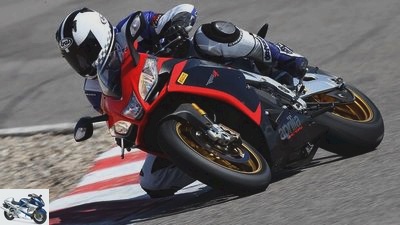
markus-jahn.com
Accelerate out in a new way: Less lean angle results in more power output.
In the event of a sudden slide, the instantaneous shutdown of ignition / injection on one or more cylinders takes effect. Most of the time, the driver only feels the traction control warning lamp flashing yellow in the cockpit. Their regulation is still dependent on the selected driving mode. The racetrack mode activates the most aggressive set-up, right up to controlled drifts, the rain mode intervenes the earliest.
This often also drives down the maximum output, less often the torque output. In 2012 Suzuki launched a new GSX-R 1000 without ABS and traction control! Unthinkable four years later. It was only with the V-Strom 1000 that the world’s third largest motorcycle manufacturer started using traction control in 2014. It works in two clearly identifiable stages and, as is usual with enduro bikes, can be switched off for off-road use. Current super athletes from Aprilia, BMW, Ducati, Honda, Kawasaki, MV and Yamaha even have up to eight control levels.
MOTORCYCLE conclusion: Super athletes without sensitive traction control are an anachronism today. It clears your head safely and quickly, helps you accelerate in an inclined position and when there is little grip in corners. A welcome, mostly adjustable lifeline. Trust is good – traction control is better!
“Electronic” trolleys
With electronically regulated springs and dampers, digital technology even helps with the link between the road and the motorcycle. Bits and bytes now work instead of clicks!
With conventional suspension elements, you have to decide on a certain setting for the suspension base and damping before you set off. If the road surface, the load or the conditions on the (race) track change, you have to stop and readjust. Annoying when a handwheel is missing on the shock absorber, adjusting screws for fingers or screwdrivers are difficult to access. Electronically adjustable trolleys offer much more ease of use. All you have to do is press a button to electromechanically adjust the damper valves from soft to tight, even at full speed. Almost always there is also the adjustment of the preload on the central spring strut – on BMWs with Tele or Duolever also at the front: In the K 1200 S, this technology celebrated its premiere in 2004 as a BMW ESA (Electronic Suspension Adjustment) option. It is really impressive when a travel enduro becomes even higher-legged at the push of a button.
The combinations for spring base and damping resulted in nine to 15 practical settings at BMW, depending on the model, as indicated by the pictograms in the cockpit. Semi-active chassis go one step further. They automatically regulate the damping of the spring elements up to 500 times per second, depending on the quality of the road surface and driving conditions. To do this, the control unit calculates information from ABS and traction control as well as from separate spring travel and acceleration sensors. When braking, the pressure level is increased at the front to prevent the front from submerging and to keep the motorcycle more horizontal. Which minimizes rocking movements. This is also served by more compression damping at the rear when accelerating. More than 90 percent of the BMW R 1200 GS are ordered with the Extra Dynamic ESA. Compared to conventional suspension elements (MOTORRAD 3/2016), the setting range of the semi-active suspension was wider, it offers more reserves.
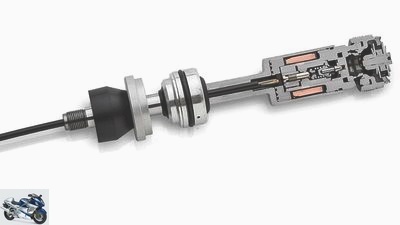
manufacturer
The electromechanically operated control valve is located on the right in this dismantled damper.
Power cables leading in are identified by electronically regulated spring elements. Admittedly, these are actually considered to be maintenance-free. But for the R 1200 GS a shock absorber with Dynamic-ESA costs over 1000 euros, a conventional one less than half. What the manufacturers use: Goods from ZF / Sachs (Aprilia, BMW, Ducati Multistrada 1200 S), Ohlins (Ducati Panigale S, Yamaha YZF-R1) and WP (Triumph Trophy SE, KTM 1190 Adventure, 1290 Super Adventure and Super Duke GT ). Conventional chassis are cheaper and less complex. Assuming good hardware and correct coordination, they work well too. Especially since the boundaries are blurring: chassis specialist Wilbers offers electronically regulated WESA struts for various models for retrofitting to previously conventionally operated chassis.
MOTORCYCLE conclusion: Electronically adjustable trolleys are more user-friendly and offer more convenience in setting. They are used for driving safety because they help avoid incorrect settings. But the technology is complex, and semi-active systems in particular are still in their infancy. And maintenance / repairs can be expensive.
Curve light
See and be seen: Bright LED headlights and special cornering lights illuminate better in an inclined position and can turn night into day.
The problem at night: In left-hand bends, the cone of light moves further and further to the left in front of the front wheel with a more inclined position and rather illuminates the sky on the right; In right-hand bends, oncoming motorists are masked and only manhole covers on the roadside are illuminated on the right.
The BMW models K 1600 GT / GTL offer more visibility through light thanks to the first “adaptive cornering light” on motorcycles: a xenon projection lens between two H7 multi-reflector headlights for the high beam shines onto the road via a reflective mirror. A servomotor swivels the mirror and thus compensates for the roll angle of the motorcycle. Even when the brakes are fully applied, the light does not move further and further in front of the front wheel, but is automatically guided further forward – and back again after braking.
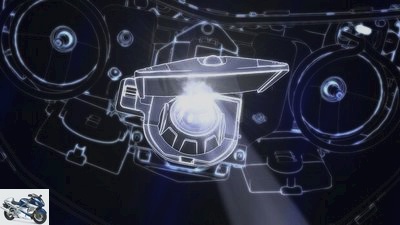
BMW
In the BMW six-cylinder engines, adaptive headlights for the xenon dipped beam are controlled by a swivel mirror in two axes.
Some modern LED headlights have an enlightening effect. A 2016 FJR 1300, for example, offers excellent high beam. This touring Yamaha also shines in the AE version with three side cornering light LED spots above the main headlights, each switched on in stages by means of a lean angle sensor. They illuminate the inner lane edge of curvy country roads much better and more precisely. This makes it easier to see angled curves. A big advantage, especially with tight curve radii. The KTM 1290 Super Adventure also successively switches on additional LED lights at ten, 20 and 30 degrees incline. They also enlarge the visible silhouette of the motorcycle.
MOTORCYCLE conclusion: Better light never hurts and makes the motorcycle easier to see for other road users (LED daytime running lights). BMW is already testing laser light. Or are there adaptive LED headlights like in cars? They detect oncoming traffic with front cameras and then selectively hide light-emitting diodes.
Cruise control
Relaxation program: A cruise control or “cruise control” easily maintains the selected speed.
This technology helps to strictly adhere to speed limits and relieves the strain on the right wrist on monotonous motorway stretches. The mechanical forerunners of cruise control were locking screws on the throttle grip, for example on government BMWs and Harley-Davidson touring bikes.
Today, the actual and target values are constantly compared and the electronically operated throttle valves are then fine-tuned to 1 km / h by accelerating on inclines and releasing the accelerator on inclines. Disengaging or braking deactivates the cruise control. Visions of the future are adaptive cruise control, as in modern cars. You maintain a previously set distance by automatically accelerating and braking.

–
This is where cruise control makes the most sense: on motorways with little traffic, especially in countries with speed limits.
On a motorcycle, however, the driver should be warned about braking maneuvers. In the event of emergency braking, he should also actively build up body tension and possibly also clutch and downshift. However, radar / ultrasonic sensors for distance measurement in the near and far range (up to 200 meters) required their space.
MOTORCYCLE conclusion: Admittedly, cruise control is often made fun of. But long connection stages are temporarily automated and more comfortable. Should there ever be an adaptive cruise control that regulates the distance automatically, stars would also be added in the area of safety. Large tourers with such technology in the fairing are conceivable.
Gearshift assistant / automatic gearshift
Shift assistants are not just for athletes: they have long been established for various touring motorcycles.
Is it about protecting the left hand or looking for tenths of a second on the race? Well, on tour and on the home straight you quickly get used to not having to close the gas or pull the clutch to shift gears. But to be allowed at any time.
With the shift assistant, or quickshifter, the gears slip into position without the slightest delay and mostly smoothly: pressing the shift lever equipped with a pressure sensor switches off the ignition for around 50 to 100 milliseconds. This brief interruption in the pulling force of the engine relieves the gear wheel, which now threads its way up to the next higher level at lightning speed.
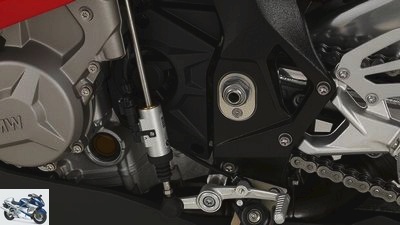
BMW
Only for super athletes? No, even if this is a BMW S 1000 RR: In general, quickshifters are on the rise.
In 2014, BMW also made it possible to downshift without a clutch (blipper) for the first time. The sensor on the gearshift lever gives the signal for a slight double-declutching thrust! It relieves the drive train and allows the shift dogs to be gently moved into their correct position.
MOTORCYCLE conclusion: Fewer domes for more comfort? It seems so. After all, it was a top tourer in 2014, the water-cooled BMW R 1200 RT, in which an optional blipper made it possible for the first time in a production motorcycle to downshift without a clutch; the boxers shift more gently with it. You quickly get used to it.
Double clutch
Automatic? Oh no. DCT is a manual transmission with two clutches, only without a clutch lever.
Honda offers its exclusive six-speed dual clutch transmission as a technique that Audi, Porsche and VW made popular. It all started in 2010 with the VFR 1200 F. Since then, this drive without clutch lever has also been available for the NC models with 700 and 750 cubic meters, the Crosstourer and the new Africa Twin. Ten kilograms of extra weight and a surcharge of 1000 euros are due for this.
Many customers order this! It is fascinating, this jerk-free shifting without noticeable interruption of tractive power: Two electrohydraulically controlled clutches quickly and gently alternately produce frictional engagement for even and odd gears, 1-3-5 to 2-4-6. On tour, it is comfortable not to have to change gears.

Honda
One clutch creates a frictional connection for the odd gears, the other for the even gears.
But you can at any time: manually using Tiptronic buttons on the left end of the handlebar, with the VFR also with an optional gear lever. There are also various automatic modes to choose from, in which the engine management system automatically shifts up early to save fuel or turns down the gears in a sporty way. When the tap is fully cocked, the kick-down function allows you to switch back quickly. class.
MOTORCYCLE conclusion: Motorcyclists’ reservations about automatic transmissions are great. But that is precisely what the dual clutch transmission is not. Its smooth, fast switching transitions are now in a good mood, the software algorithms have been noticeably improved. Just take a test drive.
Wheelie / stoppie control
Balancing on the knife edge can be fun or ouch. Electronics help with the balancing act.
Oops, it might be uplifting when the front wheel comes up. As a sign of irrepressible strength or total vehicle control. But it can also mean the opposite and cost time on the racetrack. Electronics therefore help the driver to find the right balance between wheelie and propulsion.
If the front wheel lifts beyond a certain angle, the on-board electronics recognize this via various parameters (front / rear wheel speed, gear, speed, acceleration). It then closes the throttle valve, reduces the ignition or selectively switches off cylinders.
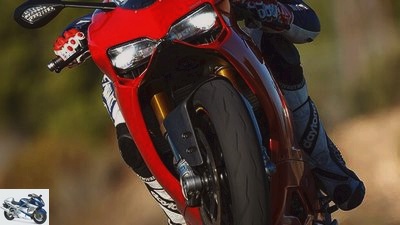
jkuenstle.de
Up the bike – but only if you really can and want it!
This gives you acceleration at the limit without the threat of a backward somersault at 200 hp. The wheelie controls of the super sports car are finely adjustable, the DWC of the Ducati 1299 Panigale has eight different control levels. Many modern super athletes also have a stoppie control, which is intended to prevent the rear wheel from lifting off when braking.
MOTORCYCLE conclusion: Sounds like a rather dispensable technology for gross motorists on the throttle at first. But in times of 160 hp naked bikes and equally potent travel enduros, the rollover prevention can also be interpreted as a real driving aid. And MotoGP racers never ride without this feature anyway.
Future projects
Many steps point the way from yesterday to tomorrow. New technologies are just around the corner. The future is no longer coming – it has long since begun.
We motorcyclists live dangerously at crossings and junctions. Because drivers overlook us (left-turners!) And take the right of way when pulling in. In the future, they could still be warned before they knock a motorcyclist over: With vehicle-to-vehicle communication, networked vehicles exchange information and data via radio (WLAN, UMTS). This enables them to report dangerous situations and impending collisions within a radius of around 300 meters at an early stage – by means of a warning tone and projections onto the (car) driver’s windshield.
The European motorcycle manufacturers, the four Japanese brands and Harley-Davidson have committed to offering a “cooperative safety system” in at least one of their models by 2020. That’s in a good three years! BMW, Honda and Yamaha are already working closely together to increase the safety of motorcycles and scooters. BMW is also planning an LTE cellular module and “Connected Ride”. It is intended to display warning notices in two-wheeled cockpits at an early stage. This includes, for example, the end of a traffic jam in a curve.
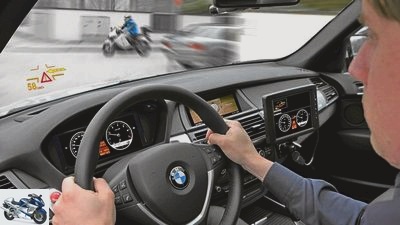
BMW
The test phase is already running: In networked vehicles, drivers are warned of approaching motorcyclists.
BMW already offers dynamic brake lights as an option for the R 1200 GS / Adventure and S 1000 XR models as well as standard for the K 1600 models. It flashes five times per second in the event of severe decelerations from speeds of over 50 km / h to warn the following traffic. If the speed falls below 14 km / h, it also switches on the hazard warning lights. In the event of a crash: In 2017, an eCall system (intelligent emergency call) will be used for the first time in the K 1600 GT / L.
The fuel-saving automatic start-stop system is already a reality in various Honda scooters: after three seconds of idling, the engine cuts out and starts up again with the slightest twist of the throttle. Something like this is also conceivable in motorcycles. The same applies to the Side View Assist from the BMW C 650 GT maxi scooter. It warns of vehicles in the blind spot: Ultrasonic sensors scan the left and right of the traffic area and use a warning triangle in the mirror boom to warn of dangerous lane changes. In 2012 Aprilia presented its multimedia platform, for example for the Caponord 1200. AMP wirelessly transmits vehicle information to the smartphone and saves it, including operating instructions and “last parking space”. When driving, the mobile phone displays many functions, such as on-board voltage and the lean angle reached.
How well the display and operation work?
A central question: How can the growing range of functions of motorcycles be appropriately displayed and operated?
What use are the best electronic helpers if there is a lack of ease of use? Do you have to laboriously zap around in the menu to select, set and regulate the assistance systems while driving and look away from the road for a long time? MOTORRAD author Werner Koch finds this trend utterly dangerous: “Scrolling, return, set, reset, all of this is prohibited while driving in cars and motorcycles because even a second of inattentiveness can have dire consequences when driving a motorcycle.” Actual traffic could be distracted, “lands in a jiffy in the opposite lane”. Graduate psychologist Sebastian Will from the Wurzburg Institute for Transport Science (WIVW) demands: “New operating concepts should be optimized with regard to intuitive usability and less distraction during input.” Karsten Schwers, who rode hundreds of different motorcycles as a tester at MOTORRAD, also attaches great importance to “simple, practical and clear operation!” For him, this includes using a separate mode switch to quickly switch between different settings for engine or chassis switch on.
The conflict of objectives: On the one hand, you want as few switches as possible, on the other hand, few multiple assignments and no cumbersome menu navigation. On the Yamaha FJR 1300, for example, the actuation of the electric disk is hidden in the on-board menu. BMW derived the “Multi Controller” for turning and pushing on the left end of the handlebar to operate the navigation system and on-board computer from the “iDrive” of the BMW cars. There is also potential for optimization for user-friendly cockpits. The displays are often overloaded with tons of information from small digits and LCD displays, as is the case with current MV Agusta models. Are you now following touchscreen monitors à la satnavs and tablets, as they have already been used in the first cars? Colored TFT displays can be helpful for contrast and visibility, as in the BMW K 1600 GT and Ducati Panigale.
Advantages and disadvantages of assistance systems

www.bilski-fotografie.de
Karsten Schwers, MOTORRAD test driver and an artist at the handlebars.
Per
What could be cooler than chasing a current super sports car such as the BMW S 1000 RR over racetracks that is crammed with all sorts of assistance systems? With various modes, I can switch from a defensive to an aggressive ABS set-up, find one or the other (tenths) of a second and still be protected from an overbraking front wheel – ABS function only at the front if desired. With the finely adjustable traction control, I increasingly increase the slip on the rear wheel until it slips at the back, but still spared a highsider. An automatic gearshift, preferably with a blipper, saves time when changing gears. With the electronic chassis, I can change the fine tuning at the push of a button. When it pumps at the rear, I adapt the damping to my driving style. You also benefit from all of these systems in everyday life. For a touring enduro or a touring motorcycle, I like to choose between a comfortable or sporty chassis set-up, depending on the section of the route. An automatic gearshift relaxes me on longer tours, the traction control can prevent a fall in the wet. And there is no need to discuss a sophisticated ABS system with fine control intervals, a curve function and just two kilograms of extra weight.
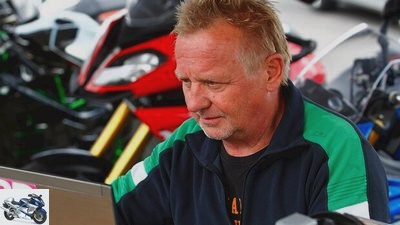
www.factstudio.de
Werner “Mini” Koch, MOTORRAD test driver and editor since 1987.
Contra
I am a long way from a radical contra to electronic systems in motorcycles. Nevertheless, the question may be asked, what happens to the countless sensors, computers and control valves when the motorcycle gets old? Half of my fleet are youngtimers, older than 30 years and still fully functional. Because solid mechanics can almost always be repaired and the used parts market is well stocked. With exceptions: Capricious control units of various (Japanese) youngtimers of the 80s are already among the components that are hardly available anymore. What will happen when the complex electronics of modern systems take off?
A simple ignition box is no longer enough if e-gas, lean ABS, traction control and, above all, electronically controlled spring elements paralyze the whole system with a thousand and one errors. I don’t believe that the electronic function makes driving safer – with the exception of ABS. Anyone who “freezes” in shock when braking in an inclined position will not knock over, even with the best ABS cornering, but rather roll into oncoming traffic. The whole electronic hocus-pocus is of no use if the driver can’t handle it. Therefore, intensive training with the active driving aids is more important than a 20-fold fine adjustment of the traction control.
Related articles
-
Driver assistance systems for motorcycles
Hirano Ami counselor Driving experience & Driving tips Driver assistance systems for motorcycles Assistance systems For comfort and security Motorcycles…
-
Active safety systems in motorcycles
Bosch 10 pictures MOTORCYCLE archive 1/10 ABS – Should prevent the wheels from locking when braking hard or on slippery surfaces. KTM 2/10 “Cornering ABS…
-
Ducati 1299 Panigale assistance systems coordinate setup
markus-jahn.com 28 pictures fact 1/28 Ducati Superbikes in a generation comparison. fact 2/28 Bite-proof and easy to dose: anchor of the 1198. ABS was…
-
Additional safety through assistance systems
Security campaign Consideration has right of way Yixin Chen 7th pictures Yixin Chen 1/7 Bosch 2/7 Adaptive Cruise Control adapts the speed to the flow of…
-
Assistance systems: traction control in the test
Jahn 13th pictures Jahn 1/13 The relations shift on the wet test track – in the truest sense of the word. Jahn 2/13 In conclusion, it can be said that…
-
Yamaha YZF-R1 driver assistance and chassis
bilski-fotografie.de counselor workshop Yamaha YZF-R1 driver assistance and chassis Assistance systems and chassis of the Yamaha YZF-R1 The perfect match…
-
Photos: Yamaha Sports & scene Electronic security features Against blocking, for traction Electronic safety features on the motorcycle Electronic…
-
Nine 48 hp motorcycles tested for the A2 driver’s license
Jahn 44 pictures Jahn 1/44 Thanks Brussels: With the new tier driving license for young drivers and newcomers, the EU has given a hefty surcharge of 14…
-
Kawasaki with radar-based assistance systems from 2021
Motorcycle fair in Milan EICMA 2021 Presented by Kawasaki counselor technology & future Kawasaki with radar-based assistance systems from 2021 Kawasaki…
-
Bosch counselor technology & future eCall systems for motorcycles eCall systems for motorcycles Challenges in accident detection and emergency calls A…